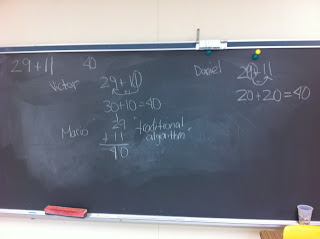Reflection on the week:
This week I decided to continue number talks with addition problems. I chose addition because after experiencing number talks a little bit last year, I realized how difficult multiplication was for them and thought that starting with addition would be a good way to help them build their confidence with number talks and sharing their ideas. Additionally, because I have so many ELL students, it was also a way to continue to have them build their communication strategies as well as work really hard to listen to each other. I thought that addition might be a better choice for this because there was a higher likelihood that they would understand what their classmates did and how it was being described.
For my first number talk of the week, I did problems of the family: 19 + 31. Below are some screen shots of
the different classes' strategies. What I found was very interesting! In two of the four classes, the traditional algorithm did not come up by students who were describing their methods. However, in these two classes, I decided to introduce it because I wanted to see if anyone used it. As I introduced it, I began by saying that this is often the way that we learn how to do arithmetic. However, algorithms are meant to be steps that we follow, but are often difficult for us to understand how and why they work. Also, when get into bigger problems, algorithms can confuse us because it is difficult to keep track of all the different numbers if we don't understand where they are coming from. I also said that it is a strategy, and if they used it, that is okay!
But, I also said that I am going to push them to understand and try other methods as well. When I went through each of the strategies to ask students to raise their hands if they had used that method, there were quite a few people to raise their hand for the traditional algorithm.
In the other two classes, the traditional algorithm did come up and in both cases I did not put emphasis on the method, but did describe the same thing about algorithms and I did in the other classes. Additionally, I pushed the students who were describing how they used the traditional algorithm to use words like "I carried the 10" not "I carried a 1" and "I then added 10 + 20 + 10" and not "I then added 1 + 2 + 1." (As seen in period 1).
In addition to the traditional algorithm however, I saw someone in every class move around the 1 from the second number to the first number, making the problem a little more easy. Another strategy I saw often was adding the ones and the tens separately. In one of the classes I saw someone round 11 to 10 to add it more easily as well.
Period 4:
Period 2:
The second number talk I did problems in the family of 19 +36. Below are some screen shots of the classes' strategies. I saw similar strategies in this problem as well. One thing that I do want to mention however is that many of the students have begun to share their ideas, even if they are extremely similar methods as those already mentioned. I am SOOO excited by this, and I have made it a point that I want to hear similar strategies as well. For example, even if a method seems the same but students added in a different order, this is different and I let them know that I want to honor that.
Period 3:
Period 1:
Period 4:Questions as I go into next week:
Overall, I was extremely pleased with how the number talks went this week. I have not had any push back from students and have not heard any comments like: this is too easy or this is for little kids. I'm not sure if it's the way that I framed number talks in the beginning of the year or if these students are being nice and playing along, but the students do not seem like it is a hassle for them or like it is a waste of their time.
Questions I am left with are: How can I keep up their enthusiasm and positive attitudes about number talks?
How can I help students who have not yet participated feel comfortable sharing?
How can I begin to have students build upon other methods they are seeing?
With all this in mind, this coming week I am taking some advice from some wonderful resources, I have decided that maybe I need to get to know a little more about how students are thinking about numbers using other operations as well. So, I'm thinking that I will do a subtraction problem to see how students are thinking about subtraction as well.









